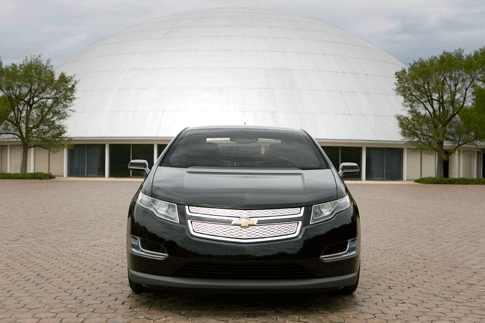GM Claims Chevy Volt Will Get 230 MPG–But How?
General Motors CEO Fritz Henderson says the EPA will certify the Chevrolet Volt with triple-digit mileage. How'd they come up with that?

[Update: The EPA issued a statement to the folks at Edmunds stepping back from GM’s mileage claim: “The EPA has not tested a Chevy Volt and therefore cannot confirm the fuel economy values claimed by GM. EPA does applaud GM’s commitment to designing and building the car of the future – an American-made car that will save families money, significantly reduce our dependence on foreign oil and create good-paying American jobs.”]
General Motors calls the Chevrolet Volt an extended-range electric vehicle. That’s because the only motive force comes from the electric motor; the gas engine only charges the batteries. In a press conference earlier today, GM’s CEO Fritz Henderson said the Volt will have a city mileage figure of 230 miles per gallon–almost five times more efficient than a Prius. But considering the uniqueness of the Volt’s powertrain, how did the EPA get that figure?
Call it a “draft methodology.” That’s a quick way of saying the EPA is developing a few assumptions to populate a new “duty cycle” for the Volt. The duty cycle is the usage profile the agency uses when determining the city and highway mileage numbers to put on a new car’s window sticker. The latest EPA cycle, set in 2006, accounts for actual driving conditions, such as high speed, aggressive driving, use of air conditioning, and cold temperature operation.
Of course, the Volt’s fuel-consumption parameters are a bit more complex. Motor Trend reported a while back that such complexity had put GM and the EPA at odds over how to calculate the Volt’s mileage. Apparently by today’s statement from CEO Henderson (and all those “230” ads you’ve been seeing and didn’t know it), GM and the EPA have apparently come to terms.
As John Voelcker from GreenCarReports.com points out, GM says the Volt can travel for the first 40 miles on battery power alone. That means, if you never drive more than 40 miles a day, your mileage is technically “infinity.” Of course, that isn’t quite accurate over longer distances. So the EPA likely adopted a test cycle that involves driving the Volt until the battery is discharged, and then for a further distance using gasoline power.
GM-Volt.com reports on a similar test routine proposed by Mike Duoba at Argonne National Laboratories, during which the Volt is driven repeatedly on four EPA highway test cycles until the battery is discharged, then drives one city cycle, totaling 51 miles. The EPA city cycle is just under 11 miles, the highway cycle about 10.26 miles. If you do the math, as Voelcker has, it works out to 232 mpg. Sounds familiar.
We’ll be watching to see when the EPA gives up the goods.
[via GreenCarReports]